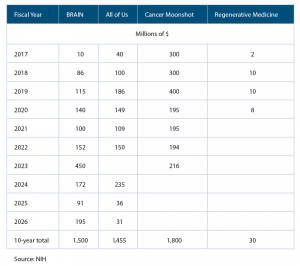A database will house and provide secure access to the data. Private and public partnerships will be established among scientists and physicians to share the data and study genetic factors, environmental exposures, and lifestyles and their impact on diseases and disorders. “Otolaryngologists partnering in the study will have access to this data and might be able to identify susceptibility genes or environmental factors that contribute to sensorineural and hereditary hearing loss,” Wong said.
Explore This Issue
August 2017BRAIN Initiative

(click for larger image) Table 1. Funding for NIH Innovative Research Initiatives under the Cures Act
This facet of the Cures Act is aimed at revolutionizing our understanding of the human brain. Researchers intend to use new imaging tools to produce a revolutionary, dynamic picture of the brain that shows how individual cells and complex neural circuits interact in real time. “Researchers will be able to see which areas of the brain are involved in normal or disease processes,” Wong said. “Being able to visualize the affected areas of the brain in an individual with tinnitus using functional magnetic resonance imaging or having the ability to image auditory processing disorders or hyperacusis in the brain in real time would have great benefits.”
This imaging data could fill significant gaps in current knowledge and provide unprecedented opportunities for exploring how the brain enables the human body to record, process, utilize, store, and retrieve vast quantities of information, all at the speed of thought. Ultimately, researchers hope they will be better equipped to treat, cure, and even prevent brain disorders.
Cancer Moonshot
The Cancer Moonshot aims to accelerate cancer research to make more therapies available to more patients, while also improving the ability to prevent cancer and detect it early. Presently, the National Cancer Institute is asking scientists to submit grant applications for cancer research. “Scientists interested in studying head and neck cancers may submit applications for support as part of this initiative,” Wong said.
Regenerative Medicine Innovation Project
Regenerative medicine is an emerging area of science that holds great promise for treating and possibly curing a variety of conditions. The initiative promotes the use of adult stem cells and other technologies—such as engineered biomaterials and gene editing—to repair or replace damaged cells, tissues, or organs.
“If scientists could coax adult stem cells to regenerate new cells to replace lost or damaged hair cells in the inner ear after hearing loss, there may be a good chance that hearing could be restored,” Wong said. “Or, if researchers could repair damaged vocal folds, that may help alleviate some voice disorders.”
Looking Ahead
Wong is optimistic about the benefits that the Cures Act’s initiatives will bring. “Although a specific study may not find a cure, it could uncover new knowledge about normal and disease processes that could lead to a cure,” he said. “Or, it could provide the necessary basic research that eventually leads to a new treatment, such as a new assistive device or a new drug.”